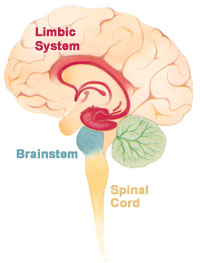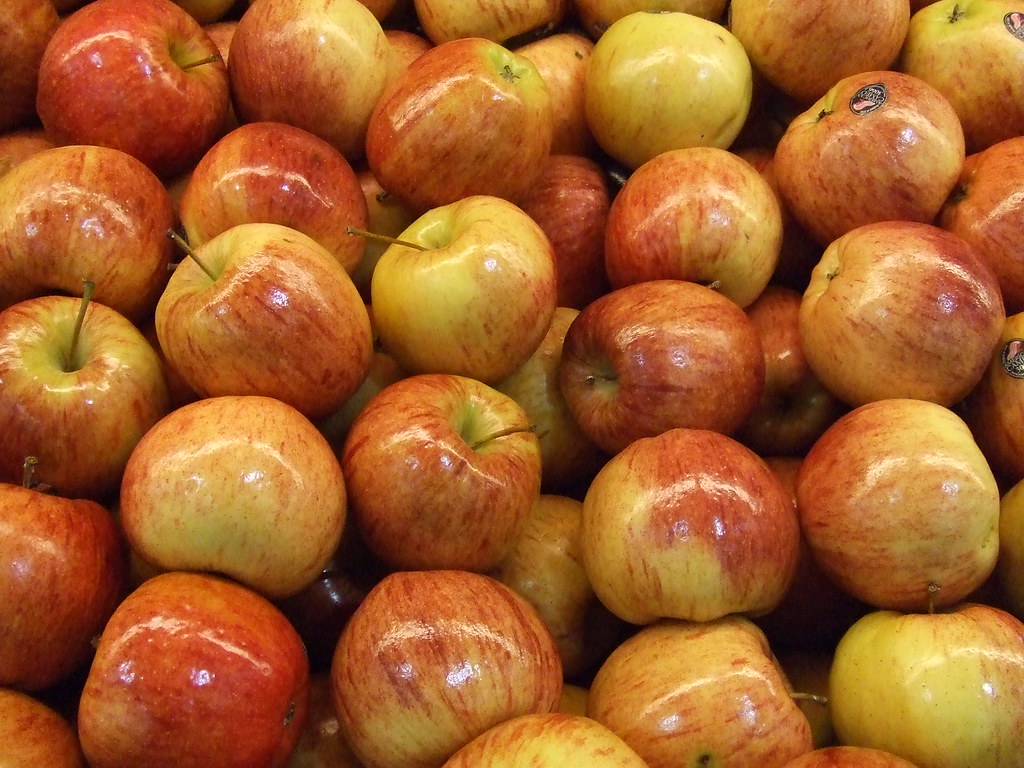This morning, I taught my CIS 470 class about the neuroscience of addiction. Brain scientists divide the brain up into three sections for evolutionary / classification purposes: the brain stem (i.e., lizard brain), the limbic system (i.e., the mammalian brain), and the cerebral cortex (i.e., the ape brain). Please note, this is not an endorsement of the evolutionary theory of species development, but we do need to understand how the academic world works with our developing understanding. Update: This model is apparently out of date with current models of thinking (http://en.wikipedia.org/wiki/Lizard_brain).
The brain stem is responsible for keeping us alive, regulating breathing, blood flow, sensitivity to light and dark, etc. The limbic system holds the keys to much of our emotional response to things. The prefrontal cortex manages the functions of rational thinking and decision making. For a basic understanding of the neuroscience of addiction, we need to begin our discussion with the limbic system.
The limbic system is responsible for our basic emotional drives to things that keep us as individuals and as a species alive: food, safety, and reproduction. When your hungry and you start craving food, that’s the limbic system working. When you have a new member of the opposite sex move into the ward, and that person attracts your attention (along with the attention of many of the other members of your sex in the ward) that’s the limbic system at work. If you’re driving down the road, and an animal or car unexpectedly darts out in front of you and grabs your attention, that’s your limbic system again. Your limbic system helps motivate you to act in ways that will get you the food, safety from physical threats, and reproductive opportunities you need to survive.
In basic terms, your limbic system (and much of your brain) works by sending signals through specialized regions of the brain, which are connected by neurons (or nerve cells) shown below.
These neurons are like sprawling highways across your brain. However, the neurons are not physically connected. At the ends of the neuron, there is a small (very small) gap, called a synapse. Within the neuron, signals are passed electrically. But between the neurons, signals are passed chemically.
The activated neuron releases a chemical, known as a neurotransmitter, which passes across the synapse and attaches to receptors. The more receptors that bond with the neurotransmitter chemical, the stronger the signal / activation in the connected neuron. That activation travels across the neuron to other connection points between neurons and the process continues through the system.
One of the key neurotransmitters used in the limbic system is dopamine. Certain cues in our environment trigger activation of the neurons in our limbic system sending dopamine and the resultant electrical activations across the nerve cells in the limbic system. The result is we experience an “orienting response” that directs our attention and actions toward whatever was stimulating us.
One of the challenges of the limbic system is that it wasn’t engineered for our modern society. To illustrate, let’s look at the following:
I showed a photo like this to a classroom full of students today and asked what they saw. By and large, the answer was “apples.” I told them they were all wrong. What they actually saw was an image of a set of apples. These aren’t real apples. You cannot eat them. (I tried to eat them in front of the class, but was clearly unsuccessful). When we stop to think about it, this makes perfect sense. No one would rationally think they could eat food that appears on a projection screen. The trick is, our limbic system doesn’t know that. Our mammalian brains have no way of knowing the difference between a picture of an apple and a real apple. That’s because, for thousands of years, if we saw something that looked edible, it likely meant (if we could catch / harvest it) we were going to eat soon.
It reminds me of a passage from Isaiah:
And the multitude of all the nations that fight against Ariel, even all that fight against her and her munition, and that distress her, shall be as a dream of a night vision. Yea, it shall be unto them even as unto a hungry man who dreameth, and behold, he eateth, but he awaketh and his soul is empty; or like unto a thirsty man who dreameth, and behold, he drinketh, but he awaketh, and behold, he is faint, and his soul hath appetite. Yea, even so shall the multitude of all the nations be that fight against mount Zion.http://www.lds.org/scriptures/jst/jst-isa/29.7?lang=eng#6
Thus looking at pictures of food, particularly when we’re hungry, starts activating the neural circuits that lead to craving / anticipating the reward we’re going to feel when we eat it. The impression on our brain is even stronger with images of high calorie / high-fat foods. (Such foods used to be really scarce). From what I’ve read, video is even more realistic for our limbic system.
The limbic system also responds to cues for novelty. If something shows up in the environment and is new, we need to determine quickly if it’s 1) a threat to our safety, 2) edible, or 3) a potential companion / mate. So new stuff gets our attention quickly. Food gets our attention quickly. Violence / physical threats get our attention quickly, and sex gets our attention quickly.
So when you go to the grocery store, and stand in the checkout line, look around. What do you see. A bunch of stimuli designed to get the attention of the limbic system. Magazines advertising the latest gossip (new stuff). Other magazines with enormous pictures of desserts (along with headlines advertising the secrets for how to lose 10 pounds in 2 days). Rows and rows of candy bars (high fat, high calorie foods). More magazines with sexualized (and digitally enhanced) images and titles designed to entice your limbic system. Toss in refrigerators full of ice cream, sodas, and energy drinks, and you’ve created a literal dopamine gauntlet for the tired shopper who often lacks enough blood sugar to use his / her cortex to process any of this stimuli rationally. The end result is you’ve spent more money than you anticipated. Marketers have a very good understanding of how the brain works. I believe that consumers need to understand this as well to protect themselves.
Drugs and the Limbic System
In the previous section, I talked about how dopamine crosses the synapse to activate certain receptors of a neighboring neuron. After a certain amount of time, dopamine that is still in the synapse is reabsorbed by the transmitting neuron. This process is known as reuptake. Certain drugs can increase the amount of dopamine in the synapse. For example, when cocaine enters the system, it can block the dopamine transporter, thereby preventing reuptake of the dopamine within the synapse. The flooded synapse results in an excessive activation of the receiving neuron, which produces a feeling of euphoria.
Source: http://upload.wikimedia.org/wikipedia/commons/thumb/e/e0/Synapse_Illustration2_tweaked.svg/300px-Synapse_Illustration2_tweaked.svg.png
When too much dopamine is available, the neuron will discard some of the dopamine receptors. When this happens, and the drug chemicals leave the body, normal life experiences generate a normal level of dopamine, but it’s not enough to cause a normal activation response, because now there are fewer neurotransmitter receptors. This leads to feelings of withdrawal and anticipation / cravings for the drug again. As this cycle occurs repeatedly, drug addicts often report having to take drugs just to feel normal. These addictive chemical reaction cycles occur with drugs, pornography, certain foods, and other addictive stimuli.
One good piece of news in all this is that after an individual “stays clean” / abstains long enough from drugs, the body will begin to restore the levels of needed neurotransmitter receptors. But this takes weeks / months / years. The challenge is that, in addition to dealing with the addictive effects of the drug, individuals have to create new habits, to replace the existing behaviors that have developed around the drug use. During this period of detoxification, it’s very important to take part in activities that naturally increase your dopamine levels. These activities include exercising, interacting at a social level with members of both sexes, learning a new skill, taking part and progressing on a significant project, sleeping well, and participating in family activities.
Internet Addiction
Now, this is an information sciences class, and one of the things we’re trying to figure out is how all this knowledge can inform our understanding of Internet addiction. The Internet is a tremendous transportation and replication network--making access to novel and intensive stimuli in virtually any form (images of indulgent food, pornography, violent games) immediately available in a virtually limitless variety. Unlike actual food consumption, we have little in the way of a physical off switch (like feelings of fullness or physical sickness after eating too much) to get us to stop stimulating ourselves with the Internet. We can thus get stuck in a vicious cycle of checking one more YouTube video, one more status update, one more web page, one more email, etc. in a search for something to increase the level of dopamine in our limbic system synapses.
This hyperstimulation also erodes our ability to concentrate on one thing long enough to give our cortex time to thoroughly process it. Several minutes into a long book chapter or lecture, we start feeling restless, distracted, or sleepy. We start using the Internet not just as a tool for gathering and communicating needed information, but as a vehicle for waking ourselves up, for stimulating our brains. Left unchecked, this behavior makes us really good at responding to immediate stimuli--and in many ways dependent on them--while making us weaklings in terms of our ability to critically think about and ponder on a given issue.
It’s challenging for us in the computer and information sciences to avoid the Internet while recovering from these addictions, because we need it for our careers. Furthermore our society is increasingly reliant on the network for our personal and business activities. But an awareness of what’s happening will, hopefully, make us more mindful of our online behaviors. And as we live more fully enriching lives in the real world we will find ourselves seeking less stimulation in the virtual world.




